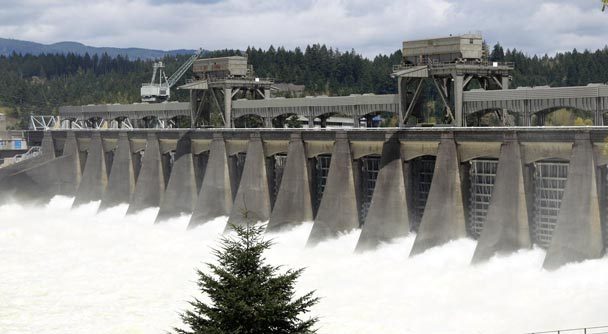forum
library
tutorial
contact

The Pacific Northwest's Wind Fleet
Integration Struggles
by Eric Christensen
Power Magazine, April 1, 2013
|
the film forum library tutorial contact |

|
The Pacific Northwest's Wind Fleet
by Eric Christensen
|
 Mae West said, "Too much of a good thing can be taxing." The Pacific Northwest has a good thing -- plentiful, carbon-free power from its huge wind and hydroelectric fleets. But wind's huge variability can be taxing. The Northwest's scramble to integrate growing wind generation, and the resulting litigation melee, underscore the importance of quickly solving the variable resource integration puzzle.
Mae West said, "Too much of a good thing can be taxing." The Pacific Northwest has a good thing -- plentiful, carbon-free power from its huge wind and hydroelectric fleets. But wind's huge variability can be taxing. The Northwest's scramble to integrate growing wind generation, and the resulting litigation melee, underscore the importance of quickly solving the variable resource integration puzzle.
Over the past decade, wind generation in the Northwest has exploded. Wind capacity has grown from almost nothing to nearly 5,000 MW in the region's largest balancing area, the Bonneville Power Administration. Already, hourly ramps from wind generation regularly exceed 2,000 MW. These rapid ramps will continue to grow with the size of the wind fleet, which Bonneville expects to reach 6,000 MW to 7,500 MW by 2017. With its huge carbon-free capacity and flexibility to rapidly adjust output, the Northwest's hydro system is ideally suited to balance these ramps. But the hydro system is now often taxed to the breaking point to reliably integrate large volumes of wind generation.
The immediate problem stems from Clean Water Act limits on dissolved gases. These limits are designed to protect aquatic creatures, including endangered Columbia River salmon, from "gas bubble trauma" -- the equivalent of "the bends" in human divers. To avoid violating dissolved gas limits, Bonneville runs water through hydroelectric turbines (which does not increase dissolved gases) rather than spilling water over dams (which does). But the resulting hydro generation, when it coincides with high wind generation, has periodically exceeded regional demand. Twisting the knife, the Washington State Court of Appeals recently rejected an attempt to increase dissolved gas limits on the Columbia River, denying Bonneville an added measure of flexibility to avoid curtailments.
Destructive Litigation
Bonneville has twice proposed solutions to this problem, relying on curtailments to wind generation. Wind producers complain that Bonneville's curtailment policies impose unique burdens on them, causing, for example, lost production tax credits and renewable energy credits, in addition to lost power production. The Federal Energy Regulatory Commission's (FERC's) decisions raise fundamental legal questions concerning the extent to which Bonneville policy will be dictated by FERC, as opposed to the regional interests that have traditionally held sway at Bonneville, and litigation can therefore be expected to continue for years.
However, the litigation involves trivial amounts of power. Only about 150,000 MWh of wind production have been curtailed over the past two years in a region that consumes roughly 170 million MWh annually. Worse, the litigation has driven a wedge between wind producers and many of their natural allies. The wind boom has breathed new life into struggling rural economies across the region. But those same rural areas are mostly served by publicly owned utilities that rely on power from the federal hydro system, and many in the rural Northwest view the wind generators' litigation as an attack on this vital resource.
The Real Problem Is Elsewhere
Most importantly, the litigation ignores the Golden Bear in the room -- California's protectionist policies that have effectively walled off its robust renewable energy market from the rest of the West. California's policies are vulnerable legally because, for example, they violate the U.S. Constitution's "dormant" Commerce Clause. Yet, while Northwest renewable energy interests squabble over trivial amounts of power, California's destructive policies have gone unchallenged. And the curtailment issue is merely a symptom of the ultimate problem -- even the Pacific Northwest's vast hydroelectric system lacks the capacity to integrate ever-greater amounts of variable wind generation.
To solve the wind integration problem, the Northwest needs to attack counterproductive policies like California's. It also needs to grow the regional capacity pie. The region is already exploring improved coordination between balancing authorities and other short-term measures that will marginally improve its ability to integrate variable resources. Additional physical storage capacity is also critical. Hence, the region needs to explore major investments in proven technologies like pumped storage, as well as cutting-edge storage technologies like advanced batteries. Electrification of the regional transportation system coupled with "smart grid" technology may allow electric car batteries to become a major storage resource. The region also needs to improve transmission links to the major storage reservoirs in British Columbia and expand the footprint of its wind fleet so that the fleet's output is more diverse and therefore easier to integrate. Finally, the region needs to encourage greater use of nonvariable renewables like geothermal.
Following this path, the region can continue developing its diverse renewable energy resources. If it does so, it may find, as Mae West also said, "Too much of a good thing can be wonderful!"
learn more on topics covered in the film
see the video
read the script
learn the songs
discussion forum
